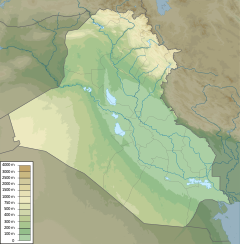
Back Meuseujid Raya Samarra ACE Groot Moskee van Samarra Afrikaans جامع الملوية (سامراء) Arabic المسجد الجامع فى سامراء ARZ Gran mesquita de Samarra Catalan Granda Moskeo de Samaro Esperanto Gran Mezquita de Samarra Spanish Sāmarrā’ suur mošee Estonian Samarrako meskita handia Basque مسجد جامع سامرا Persian
| Great Mosque of Samarra | |
|---|---|
 | |
| Religion | |
| Affiliation | Islam |
| Ecclesiastical or organisational status | Mosque |
| Status | Inactive |
| Location | |
| Location | Samarra, Iraq |
Location in Iraq | |
| Geographic coordinates | 34°12′21″N 43°52′47″E / 34.20583°N 43.87972°E |
| Architecture | |
| Type | Islamic |
| Style | Abbasid |
| Founder | Al-Mutawakkil |
| Date established | 848 CE |
| Completed | 851 CE |
| Destroyed | 1278 CE |
| Specifications | |
| Minaret(s) | 1 |
| Minaret height | 52 metres (171 ft) |
| Official name | Samarra Archaeological City |
| Criteria | Cultural: ii, iii, iv |
| Reference | 276 |
| Inscription | 2007 (31st Session) |
| Endangered | 2007- |
| Area | 15,058 hectares (37,210 acres) |
| Buffer zone | 31,414 hectares (77,630 acres) |
The Great Mosque of Samarra (Arabic: جَامِع سَامَرَّاء ٱلْكَبِيْر, romanized: Jāmiʿ Sāmarrāʾ al-Kabīr, Arabic: مَسْجِد سَامَرَّاء ٱلْكَبِيْر, romanized: Masjid Sāmarrāʾ al-Kabīr, or Arabic: ٱلْمَسْجِد ٱلْجَامِع فِي سَامَرَّاء, romanized: al-Masjid al-Jāmiʿ fī Sāmarrāʾ, lit. 'The Congregational Mosque in Samarra') is a mosque from the 9th century CE located in Samarra, Iraq. The mosque was commissioned in 848 and completed in 851 by the Abbasid caliph Al-Mutawakkil who reigned (in Samarra) from 847 until 861. At the time of construction, it was the world's largest mosque.[1] It is known for its 52 metres (171 ft) high minaret encircled by a spiral ramp. The mosque is located within the 15,058-hectare (37,210-acre) Samarra Archaeological City UNESCO World Heritage Site, listed in 2007.[2]
- ^ al-Amid, Tahir Muzaffar (1973), "The Abbasid Architecture of Samarra in the Reign of both al-Mu'tasim and al-Mutawakkil", Baghdad: Al-Ma'aref Press: 156–193
- ^ "Unesco names World Heritage sites". BBC News. 2007-06-28. Retrieved 2010-05-23.
